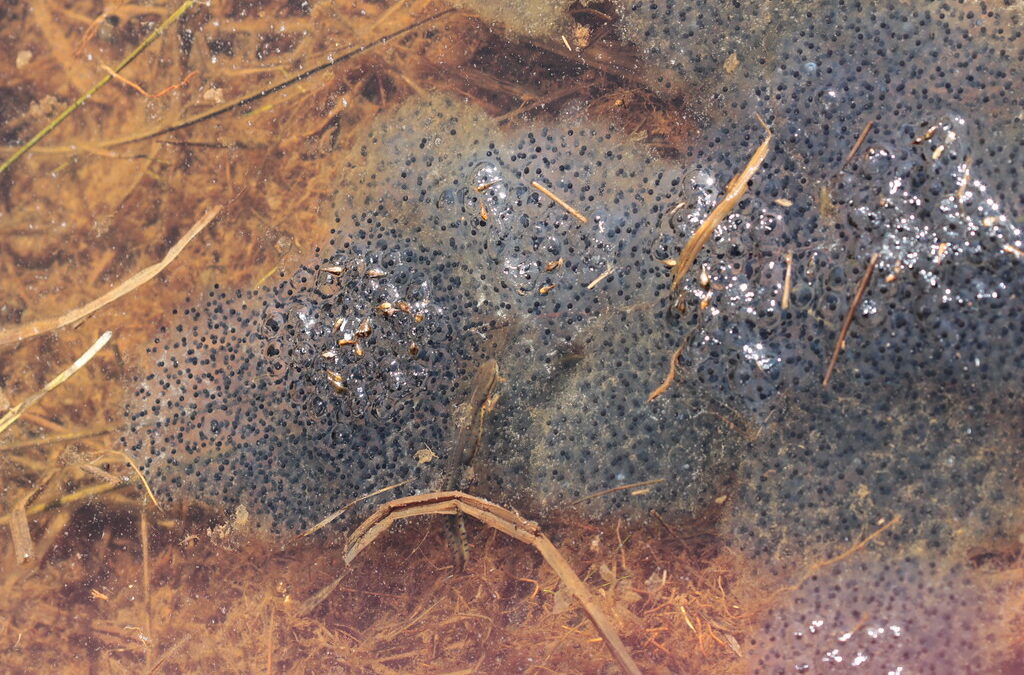By Sarah Hatfield
We were supposed to be planting trees. Three Black Gum trees have been patiently (or frustratingly – its hard to tell with trees) waiting in their pots all winter, eager to spread their roots. We were deciding on spots and talking it over and then I said “I want to see if the toad eggs hatched first.” Down the figurative slippery slope we went (the grass was quite dry so no actual slipping took place).
The toad eggs had indeed hatched. Barely. Little, tiny specks of elongated ink drops decorated the previously sediment-covered strings of eggs. We watched a bit to see if they were wiggling, but not yet. It had taken longer than I thought for them to hatch, but then again, they are in a pool at the top of the spring field so the water is much colder than lower down in the vernal pool. The vernal pool is a fishless pool of water where amphibians lay eggs in the spring.
We dug out the vernal pool quite a few years ago. It is a spring treat to go and see who uses it every year. The pond below it has fish — lots and lots and lots of very famished, finned predators — and to help out the amphibian population we thought a vernal pool would be a nice gesture.
Wood Frogs have dramatically increased in number over the years. Their floating masses of eggs cover a solid quarter of the pool now. Spotted Salamanders also come annually, always choosing one particular side of the pool. Newts are year-long residents, and there are many insects that seem to hang out all year as well. Green Frog tadpoles spend their first two years there, looking gargantuan compared to the amphibians that only take one year to mature. The deer wander through, and the Raccoons snack on the eggs and frogs they can reach and catch.
After studying the toad eggs, we went to check the vernal pool. Oh. My. Millions of tadpoles. The water was black with them. It seemed like this year that every single wood frog egg hatched and then some. The salamander larvae were still snuggled in their gelatinous eggs – probably fearful of emerging to such chaos! There were mini feeding frenzies where slugs and snails had fallen in, the tadpoles voraciously consuming them. They were also feasting on worms and one dead peeper so enthusiastically that they were churning up mud with their teensy tails. We nicknamed them the “puddle piranhas.”

Then we noticed that many of the wood frog tadpoles were being washed over the dam. Being a spring-fed pool, it is always running, so there is a little rivulet that travels over the dam and tumbles through a series of boulder-strewn pools on the way to the pond. In the first little downstream pool, hundreds of tadpoles. In the next, hundreds of tadpoles. In fact, the only pool that didn’t have tadpoles in it was the one right before the pond. So many tadpoles! I wonder what will happen in the next rainstorm… will more wash down? Will they reach the pond? Will they know enough to not venture from the edge lest the fishes devour them?
We spent a lot of time meandering from pool to pool, consistently mesmerized by the unrelenting motion of the hoard. It started to seem meditative after a while, the way fish tanks are. Calming, unpredictable, yet soothing. We started talking about making a couple more pools, maybe an upper one and a middle one. Expand the phenomena, grow the populations!
The tadpoles are mostly Wood Frog, though a few smaller ones are in there, perhaps Spring Peeper. And while we were investigating, we heard a sound that I hadn’t heard in years, and never up on the hill. A Pickerel Frog was calling! I wonder if they have always been there, or if they’ve been lured in by the ever-increasing amphibians singing the praises from the pool.
The toad tadpoles will hatch soon and add to the numbers. Perhaps the Green Frogs will start their choruses and contributions soon. It was a lovely distraction within a task, and a rewarding feeling to know that our efforts to make the wildlife feel as at home as we do were paying off. And as we get more comfortable, we hope they do too.
And we were just aiming to plant some trees… The more time you take to look, the more you discover. The Red-winged Blackbird nest right there; the colorful spring warbler drinking gratefully from the sapsucker’s holes; the discarded Barred Owl feather under the hemlocks.
There are always more chores to do, but a twenty minute distraction can create a lifetime of memories a few minutes at a time.
Audubon Community Nature Center builds and nurtures connections between people and nature. ACNC is located just east of Route 62 between Warren and Jamestown. The trails are open from dawn to dusk as is Liberty, the Bald Eagle. The Nature Center is open from 10 a.m. until 4:30 p.m. daily except Sunday when it opens at 1 p.m. More information can be found online at auduboncnc.org or by calling (716) 569-2345.


Recent Comments